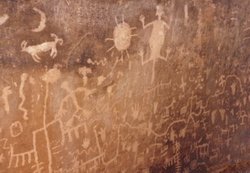Petrified Forest National Park
|
|
Petrified Forest National Park is located in northeastern Arizona, along Interstate 40 between Holbrook and Navajo. It features one of the world's largest and most colorful concentrations of petrified wood, mostly of the species Araucarioxylon arizonicum. The park consists of two large areas connected by a north-south corridor. The northern area encompasses part of the multihued badlands of the Upper Triassic Chinle Formation known as the Painted Desert. The southern area includes colorful terrain as well as several concentrations of petrified wood. Several American Indian petroglyph sites are also found in the southern area.
The Petrified Forest area was designated a National Monument on December 8, 1906. The Painted Desert was added later, and on December 9, 1962, the whole monument received national park status.
The park covers 93,532.57 acres (378.513 km²). Hiking opportunities are limited. The longest established trail in the park extends for only two miles; the others are one mile or less. Backcountry camping and hiking are allowed by permit only. However, a road does extend through much of the park. Landmarks include the Agate House, built of petrified wood, and the Agate Bridge, a petrified log spanning a wash.
The petrified wood of the Petrified Forest is the 'State Fossil' of Arizona. The pieces of permineralized wood are fossil Araucariaceae, a family of trees that is extinct in the Northern Hemisphere but survives in isolated stands in the Southern Hemisphere. During the Late Triassic, this desert region was located in the tropics and was seasonally wet and dry. In seasonal flooding, the trees washed from where they grew and accumulated in sandy river channels, where they were buried periodically by layers of gravelly sand, rich in volcanic ash from volcanoes further to the west. The volcanic ash was the source of the silica that helped to permineralize the buried logs, replacing wood with silica, colored with oxides of iron and manganese. Several major and many smaller concentrations of petrified wood occur in the park, corresponding to several stratigraphic intervals in the Sonsela Member and aptly named Petrified Forest Member of the Chinle Formation. The major concentrations have been termed "forests" (e.g. Rainbow Forest, Crystal Forest, Black Forest, etc.) although the vast majority of the fossil tree trunks are preserved in a prone position and have been transported at least some distance from their original growth areas. However, in-place stumps of trees do occur in several areas (not easily accessible to the casual visitor), and many of the logs probably did not travel far before burial.
Theft of petrified wood has remained a problem despite protection and despite the fact that nearby vendors sell wood collected legally from private land. Despite a guard force of seven National Park Service rangers, and fences, warning signs and the threat of a $275 fine, about 12 to 14 tons of the fossil wood disappears from the Petrified Forest every year.
The Chinle Formation at Petrified Forest National Park also has produced abundant fossil leaves, vertebrates (including giant crocodile-like reptiles called phytosaurs, large salamander-like amphibians called metoposaurs, some of the earliest dinosaur fossils from North America), and invertebrates (including freshwater snails and clams).
Much of the striking banded coloration of the Chinle Formation badlands that make up the Painted Desert region is due to soil formation (pedogenesis) during the Late Triassic. These paleosols (ancient soils) preserve evidence of conditions during the Triassic including the nature of the landscape and the paleoclimate. The Chinle paleosols suggest that the climate was dramatically seasonal, with distinct very wet and very dry seasons. This climate was probably similar to the modern monsoon of the Indian Ocean region, and was characteristic of tropical areas of Late Paleozoic and Early Mesozoic Earth when all the continents had assembled to form the supercontinent Pangaea.
The Petrified Forest (1936) is a film, a gangster thriller starring Bette Davis, which uses the Petrified Forest area as an atmospheric isolated setting.
See also
- List of U.S. national parks
- Petrified forest of Lesbos
External links
- National Park Service website (http://www.nps.gov/pefo/index.htm)
- Private website (http://www.petrified.forest.national-park.com/)
- Photos of Petrified Forest National Park - Terra Galleria (http://www.terragalleria.com/parks/np.petrified-forest.html)
- Photographic virtual tour of Petrified Forest National Park (http://www.UntraveledRoad.com/USA/Parks/PetrifiedForest.htm)



